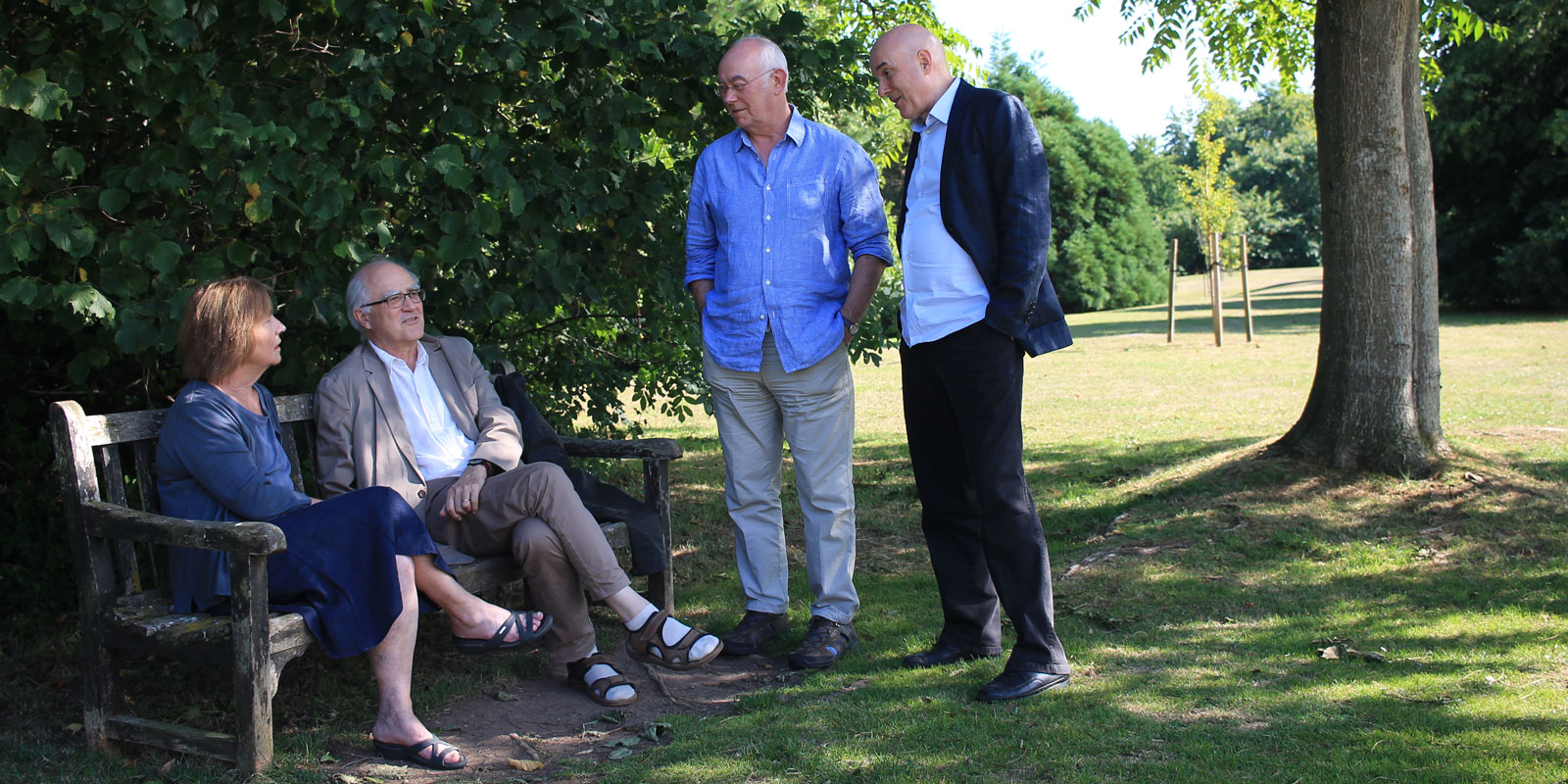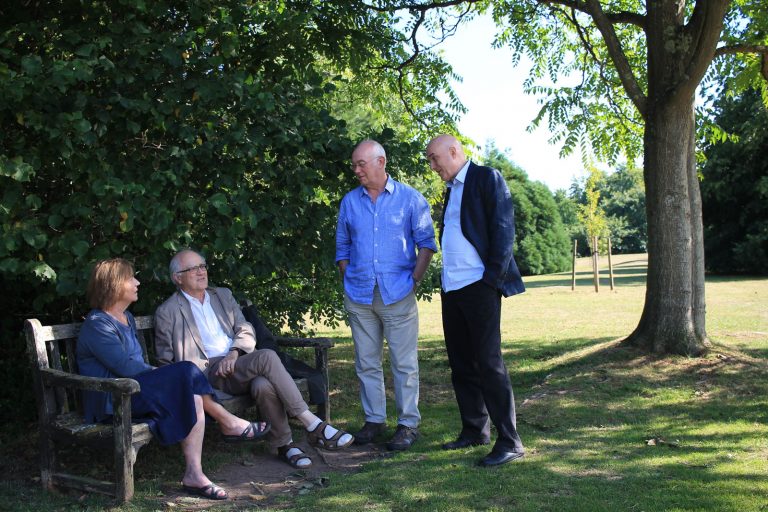What Mindfulness Is Not
As interest in mindfulness booms, four Buddhist teachers discuss the history and meaning of the term and how it can get distorted in the popular imagination. The post What Mindfulness Is Not appeared first on Tricycle: The Buddhist Review.

Meditation Meditation Month 2023
As interest in mindfulness booms, four Buddhist teachers discuss the history and meaning of the term and how it can get distorted in the popular imagination.
A conversation with Stephen Batchelor, Christina Feldman, Akincano M. Weber, and John Peacock Jan 02, 2023 Bodhi College teachers (l-r) Christina Feldman, Stephen Batchelor, John Peacock, and Akincano Weber
Bodhi College teachers (l-r) Christina Feldman, Stephen Batchelor, John Peacock, and Akincano WeberWhile the practice of mindfulness has its roots in early Buddhist teachings, the term has become a buzzword in recent years. It sometimes serves as a catch-all for any type of meditative activity while at other times it is narrowly defined as a stress-relieving technique. The faculty at Bodhi College have made it their mission to cut through the hype and help people understand mindfulness in its rich historical, religious, and philosophical context.
The following conversation, an excerpt from our online course, Mindfulness: Its Origins, Purpose, and Transformational Power, examines the ways that mindfulness is sometimes misrepresented and how a better understanding can lay the groundwork for a more fruitful practice. But more fundamentally, the talk seeks to answer a deceptively simple question: what is mindfulness?
***
Christina Feldman (CF): One of the effects of mindfulness is that it illuminates the world inwardly and outwardly. It brings things to light. We can see this in a very practical manner: if you go for a walk in the garden while your mind is filled with distractions, you may realize nothing has touched you. If you do exactly the same exercise with mindful awareness, the world comes to life.
Inwardly, mindfulness reveals our personal story—the way our minds work, our patterns, our habits, our views, our aspirations, our hopes. But it also brings to light the universal story, through the four noble truths [the Bodhi college faculty previously has discussed the merits of the alternative translations “four ennobling truths” or “four noble tasks”]. We could spend decades reviewing our personal story without necessarily feeling wiser, but the four noble truths frame our story within the universal one: sometimes life hurts, but sometimes that hurting is optional.
It is important to understand that the process of cultivating mindfulness won’t always make us feel good. The inner illumination of how our minds work, our habit patterns, and our reactivity can be uncomfortable. At least initially, we would rather not know about this stuff. We would like a quick fix. But this is the stuff we have to meet, understand, embrace, and investigate if we want to make it to the third ennobling truth—where distress can come to an end.
Akincano Weber (AW): That’s one of the challenges in both the Buddhist and secular mindfulness world. There is a tendency to isolate mindfulness as either a specific mind function or as a universal panacea that immediately makes us feel good. Mindfulness is presented as creating a safe, happy place where I can savor the world of my senses. That notion has to be challenged.
Stephen Batchelor (SB): Yes, I think this is absolutely right. Mindfulness is a total embrace of life itself, which includes its richness and the beauty but also opens us up to its tragic and painful dimension—the things that we prefer to forget. The word sati, mindfulness, means to remember. It means to recall those dimensions of our lives that we prefer to put out of mind.
Perhaps more crucially, mindfulness also means being mindful of the four noble truths. The classical Buddhist treatment of the four mindfulnesses in the Satipatthana Sutta culminates in being mindful of the four noble truths, which are essentially an operative framework of meaning and purpose that should be held in mind. This type of mindfulness consciously integrates the nuts-and-bolts practice of being more attentive and aware into that framework.
John Peacock (JP): One of the phrases you used would actually work well as a translation for mindfulness: “holding in mind.” This is a really good way of understanding it. We’re holding an awful lot in mind. When we forget this part of mindfulness and forget life’s tragic dimensions, we end up seeking an idealized version of something we want rather than embracing what already is.
SB: That’s true. In the secular mindfulness world, many people—if not most—are drawn to this practice because of suffering. They may have a health issue or anxiety attacks, for example. Often, that is their starting point. But while some of the popular literature suggests that mindfulness is a shortcut to happiness, it’s really a long cut to happiness.
We have to start paradoxically. If you really want to be happy, the first thing you have to do is embrace your suffering, which is completely counterintuitive. Therein lies the genius of the Buddhist solution. You want to be happy? OK, recognize how much you suffer.
CF: I’ve had people tell me that they believe they were happier before they began to cultivate mindfulness. But I think what they’re actually saying is that they used to find it easier to forget. One thing we don’t say in the advertising for our mindfulness course is that once you begin to wake up, it’s actually quite challenging to fully go back to sleep.
AW: Something else that can get overlooked is that mindfulness is a team player. It’s not the one thing that does it all. It’s about as famous as you can be on Buddhist charts. But I have not come across a passage in the Buddhist literature that says, “Mindfulness is the one thing that makes you free, awake, or happy all the time.”
While some of the popular literature suggests that mindfulness is a shortcut to happiness, it’s really a long cut to happiness.
What the Buddhist teachings do say is that mindfulness plays a crucial role in any of those undertakings—freedom, happiness, becoming whole, waking up, growing to have a nonreactive intelligent response to our lives and our worlds. But other factors have to be present as well. Insight is one of those factors. Ethics is another. Stillness, stability, and wisdom are factors. This is part of a package. To do justice to mindfulness, we have to acknowledge that it is not doing all this work on its own.
CF: I’d like to question this word doing. I feel one of the myths that surrounds contemporary mindfulness is that I do some mindfulness. Someone might say, “I get up in the morning and do a little mindfulness.” But in my understanding, mindfulness is not something we do. Rather, there are various contemplative trainings that we undertake that require effort in order to bring this capacity and quality of mindfulness into the forefront of consciousness. The popular mythologies, however, equate mindfulness with a technique.
JP: That reduction to technique is a great danger. But mindfulness is not not doing anything, either.
SB: It’s a practice, however we define that. It is part of the eightfold path, which is something to be cultivated. The mindfulness you experience in your first session is going to be considerably transformed and enhanced as you continue developing and practicing it. But I agree that we don’t want to turn it into a technique. We want to recognize that it’s about opening up a dimension of our own lives that is qualified by a presence of mind, an openness to situations, and a willingness to just be rather than act or do something.
I would also question the idea, which Akincano raised, that mindfulness is not treated as the sole way of doing this practice. The introduction to the discourse on mindfulness says that mindfulness is the direct path to nirvana. It’s called the ekayana-magga, which you can almost translate as “the only path.” So mindfulness does have a very central and crucial role in this affair. I think it’s important to highlight that, but it’s equally important to recognize that it cannot do all of this just on its own.
JP: One of the great dangers of thinking about mindfulness in this isolated way is that we can end up forgetting all the other factors, such as courage. To go to your first mindfulness class requires effort as well as a degree of courage, because it isn’t an easy task. I’m always astonished at the courage of the people who submit themselves to this process. It is a learning, evolving process that requires their whole being.
CF: We’re spending a lot of time talking about what mindfulness is not. In a way that can be quite helpful, but we are then going to talk about our understanding of what mindfulness is. But in the vein of what mindfulness is not, for me there’s two key pieces here. The first is that mindfulness is not a standalone quality. The other piece is that mindfulness is not the destination of the path. Rather, mindfulness is an embarkation point for the development of the entirety of the path. Mindfulness and nirvana are not interchangeable terms. Mindfulness is the vehicle for developing the understanding that can liberate.
♦
Tricycle’s six-week online course Mindfulness: Its Origins, Purpose, and Transformational Power is an essential program for anyone with an interest in mindfulness, its Buddhist roots, and its role in the contemporary world. Meditators, practitioners, and therapists will benefit from the deeper practical, psychological, ethical, and contemplative understanding of mindfulness available here.
This article was originally published on September 23, 2018.
![]()
Thank you for subscribing to Tricycle! As a nonprofit, we depend on readers like you to keep Buddhist teachings and practices widely available.

 Fransebas
Fransebas 































